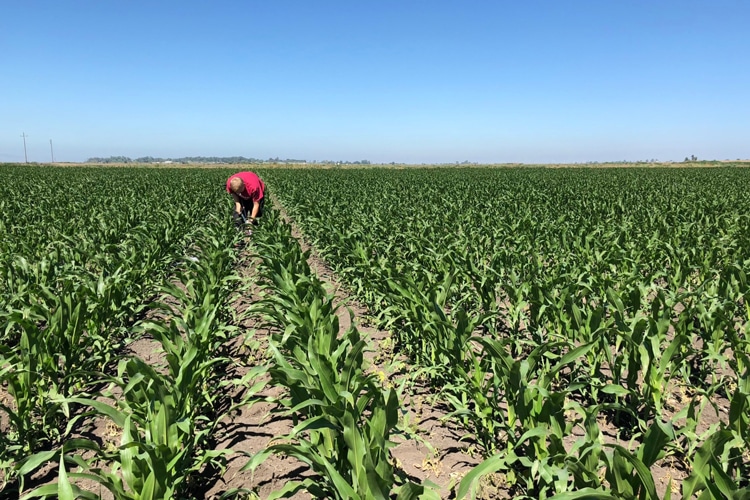Aug 30 2018
According to a latest UC Berkeley study, low-tech methods of enhancing soil quality on farms and rangelands globally could remove substantial amounts of carbon from the atmosphere and decelerate the pace of climate change.
 Widespread use of proven agricultural land management practices can help slow global warming. (Heather Dang photo)
Widespread use of proven agricultural land management practices can help slow global warming. (Heather Dang photo)
The scientists learned that proven agricultural management practices such as sowing legumes on rangelands, planting cover crops, and optimizing grazing, if introduced globally, could capture enough carbon from the atmosphere and store it in the soil to make a noteworthy contribution to universal global warming targets.
Their primary aim was to establish if such practices could decrease global temperatures by at least 0.1 °C (0.18 °F). This is one-tenth of the Intergovernmental Panel on Climate Change’s goal of controlling the average worldwide temperature increase between now and the year 2100 to 1 °C (1.8 °F), or 2 above temperatures before the industrial revolution.
When integrated with aggressive carbon emission reductions - the best setup for limiting warming from climate change - the research found that better agricultural management could lower global temperatures 0.26 °C - nearly half a degree Fahrenheit - by 2100.
As someone who has been working on carbon sequestration for a long time, I have always had this question in the back of my mind, ‘Will sequestration in soils make a difference with climate change at a global scale? We found that there are a wide range of practices deployable on a large scale that could have a detectable worldwide impact. A big take-home message is that we know how to do this, it is achievable.
Whendee Silver, Professor of Environmental Science, Policy and Management at UC Berkeley
By throwing in biochar, a debatable soil additive - basically charcoal - acquired by burning crop residue in an oxygen-free environment, these practices could offset even more warming, potentially as much as 0.46 °C (0.7 °F).
The caveat, Silver said, is that this “is only achievable if you couple sequestration with aggressive emissions reduction.” If carbon concentrations go up in the atmosphere, then sequestration becomes less effective at lowering temperature. Much more carbon has to be pulled out in order to realize the same reductions.
She and her colleagues, including lead author Allegra Mayer, a UC Berkeley graduate student, will publish their findings in the August 29th issue of the online journal Science Advances.
Storing Carbon in Soil
The IPCC has fixed carbon-reduction goals to curtail average global warming in 2100 to 2 °C above global average temperatures before the industrial revolution, or about 1760. Earth is already in the middle of that limit, having warmed 1 °C since 1880.
Silver investigated various methods to sequester carbon in soils, including composting, to eliminate some of the carbon dioxide from the atmosphere and decelerate the greenhouse-driven warming of the planet.
For the latest study, Silver, Mayer and their colleagues - Zeke Hausfather of UC Berkeley’s Energy and Resources Group and Andrew Jones of Lawrence Berkeley National Laboratory - used universal data on agricultural management approaches that are already proven to increase soil carbon storage, together with a climate model that determined the potential impacts on climate if these approaches were broadly adopted.
They originally calculated how much carbon would need to be sequestered from the atmosphere into soils to decrease temperatures 0.1 °C under four diverse scenarios, from business-as-usual emissions through 2100 to aggressive reduction of carbon dioxide emissions. For the most aggressive reduction situation, they calculated that soils would have to sequester around 0.68 petagrams of carbon annually worldwide, or 750 million U.S. tons. That is equal to 2.5 petagrams of carbon dioxide. One petagram is 1015 or a million billion grams.
Their meta-analysis of current studies of land management practices revealed that enhancing soil quality could reach and even surpass this goal, mainly from the enhancement of degraded agricultural and grazing lands that are in use but yielding less than optimally. Better management tends to raise the biomass of grass, crops, and their root systems by trapping carbon dioxide via photosynthesis, which results in additional storage of carbon in the soil.
These are very commonly used approaches, though people don’t use them to sequester carbon - they are doing it for other reasons. Anytime you increase the organic content of soils, you are generally increasing the fertility, water-holding capacity, sustainability, decreasing erosion and general resilience to climate change. Sequestering carbon is a side benefit.
Whendee Silver, Professor of Environmental Science, Policy and Management at UC Berkeley
The scientists did not look at newer practices, such as composting, that are not researched as extensively, nor did they accept the effect of enhancing soil on abandoned land, both of which could increase soil carbon sequestration even more. Newer climate models also could mimic how carbon uptake will alter as temperatures rise and rainfall patterns vary.
“The point of our paper was to look at the temperature effect of implementing existing low-tech technologies already practiced within agriculture, in developing as well as developed countries,” Mayer said. “There could theoretically be an immediate and widespread adoption of many of these practices.”
With aggressive emissions targets, enhanced land management could pull roughly 1.78 petagrams of carbon from the atmosphere yearly, while incorporating biochar into the mix could raise the annual sequestration rate to 2.89 petagrams.
“Agriculture is often portrayed as the villain in climate change,” Silver said. “What is exciting is that, not only can agriculture contribute to solving the problem, but it can do so in a way that actually improves agricultural soils.”
The project was sponsored by the Rathmann Family Foundation with further support from the U.S. Department of Energy’s Office of Science.